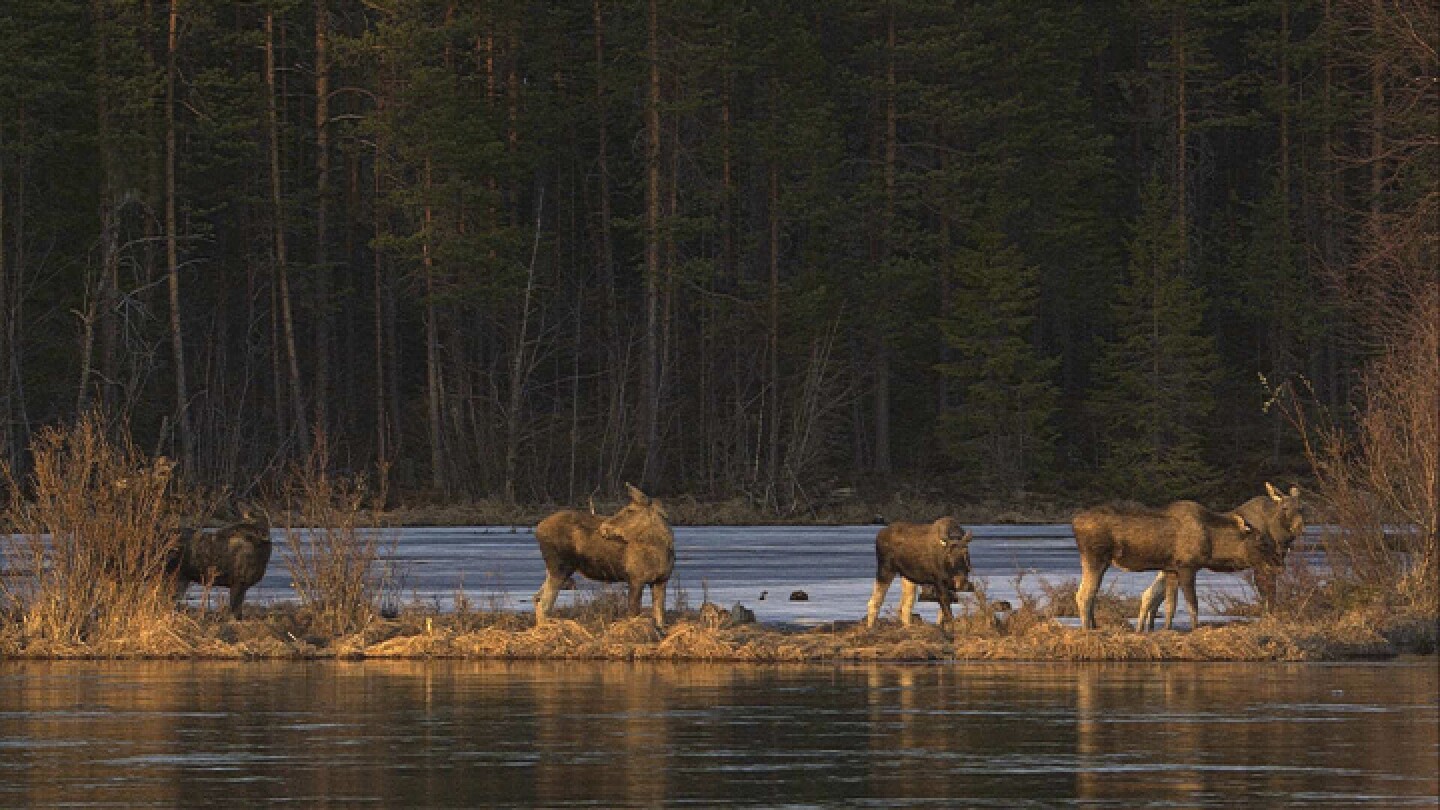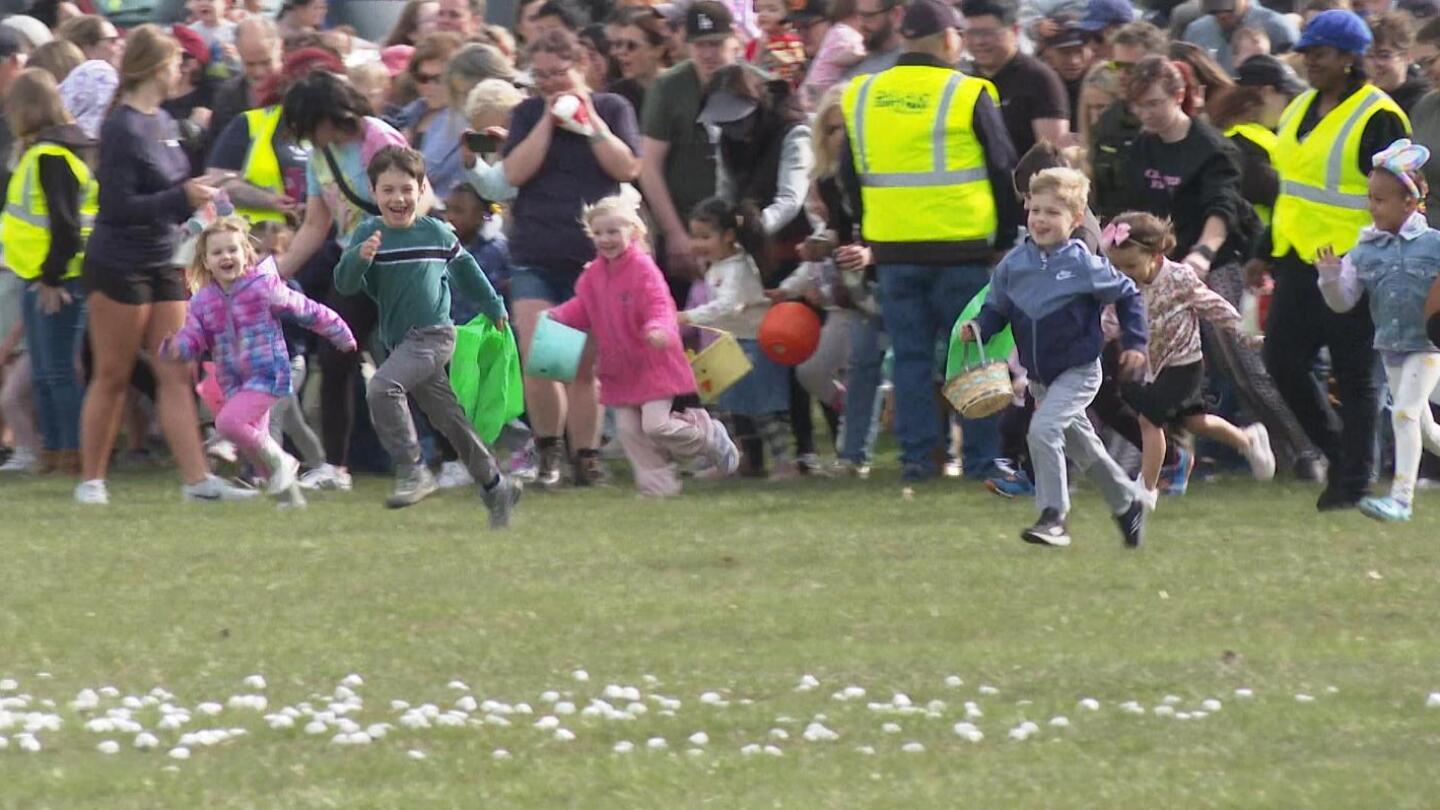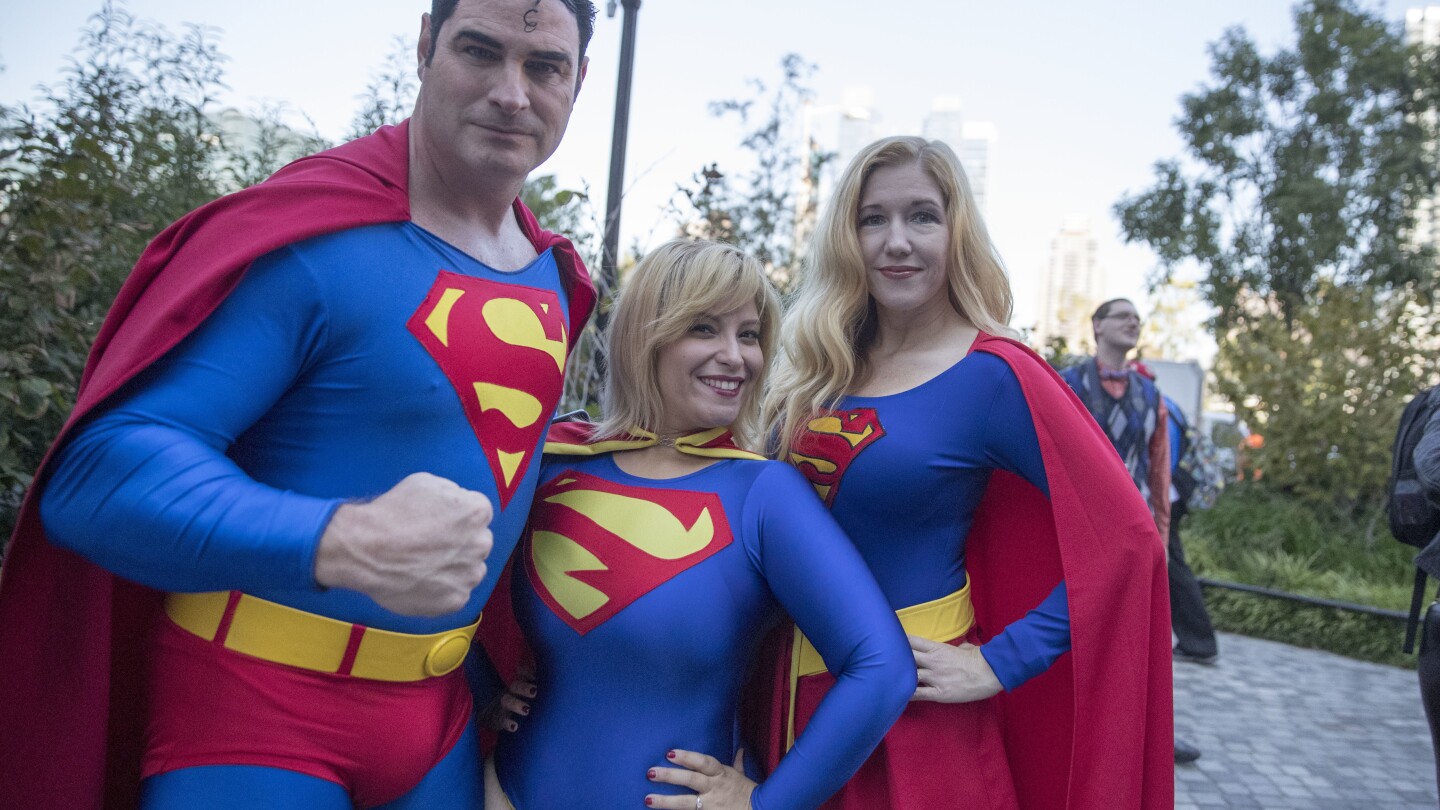Lifestyle
Livestream of moose migrating to their summer pastures fascinates millions

Before Swedish slow TV hit “The Great Moose Migration” began airing Tuesday, Ulla Malmgren stocked up on coffee and prepared meals so she doesn’t miss a moment of the 20-day, 24-hour event.
“Sleep? Forget it. I don’t sleep,” she said.
Malmgren, 62, isn’t alone. The show, called “ Den stora älgvandringen ” in Swedish, and sometimes translated as “The Great Elk Trek” in English, began in 2019 with nearly a million people watching. In 2024, the production hit 9 million viewers on SVT Play, the streaming platform for national broadcaster SVT.
The livestream kicked off a week ahead of schedule due to warm weather and early moose movement. Malmgren was ready.
This undated photo, issued by SVT, shows Moose in Junsele, Sweden during preparations for the livestream ‘The Great Moose Migration’ to document the annual Moose migration near Kullberg in northern Sweden. (SVT via AP)
From now until May 4, the livestream’s remote cameras will capture dozens of moose as they swim across the Ångerman River, some 300 kilometers (187 miles) northwest of Stockholm, in the annual spring migration toward summer grazing pastures.
Not much happens for hours at a time, and fans say that’s the beauty of it.
“I feel relaxed, but at the same time I’m like, ‘Oh, there’s a moose. Oh, what if there’s a moose? I can’t go to the toilet!’” said William Garp Liljefors, 20, who has collected more than 150 moose plush toys since 2020.
Slow TV success
“The Great Moose Migration” is part of a trend that began in 2009 with Norwegian public broadcaster NRK’s minute-by-minute airing of a seven-hour train trip across the southern part of the country.
The slow TV style of programming has spread, with productions in the United Kingdom, China and elsewhere. The central Dutch city of Utrecht, for example, installed a “ fish doorbell ” on a river lock that lets livestream viewers alert authorities to fish being held up as they migrate to spawning grounds.
Annette Hill, a professor of media and communications at Jönköping University in Sweden, said slow TV has roots in reality television but lacks the staging and therefore feels more authentic for viewers. The productions allow the audience to relax and watch the journey unfold.
“It became, in a strange way, gripping because nothing catastrophic is happening, nothing spectacular is happening,” she said. “But something very beautiful is happening in that minute-by-minute moment.”
As an expert and a fan of “The Great Moose Migration,” Hill said the livestream helps her slow down her day by following the natural rhythms of spring.
“This is definitely a moment to have a calm, atmospheric setting in my own home, and I really appreciate it,” she said.
Nature in your living room
The calming effect extends to the crew, according to Johan Erhag, SVT’s project manager for “The Great Moose Migration.”
“Everyone who works with it goes down in their normal stress,” he said.
The moose have walked the route for thousands of years, making it easy for the crew to know where to lay some 20,000 meters (almost 12 miles) of cable and position 26 remote cameras and seven night cameras. A drone is also used.
The crew of up to 15 people works out of SVT’s control room in Umeå, producing the show at a distance to avoid interfering with the migration.
SVT won’t say how much the production costs, but Erhag said it’s cheap when accounting for the 506 hours of footage aired last year.
This undated photo, issued by SVT, shows preparations in Junsele, Sweden for the livestream ‘The Great Moose Migration’ to document the annual Moose migration near Kullberg in northern Sweden. (SVT via AP)
Erhag said Swedes have always been fascinated by the roughly 300,000 moose roaming in their woods. The Scandinavian country’s largest animal is known as “King of the Forest.” A bull moose can reach 210 centimeters (6 feet 10 inches) at shoulder height and weigh 450 kilograms (992 pounds).
Despite their size, the herbivores are typically shy and solitary.
“We actually don’t see it very often. You often see it when you’re out driving maybe once or twice in your life,” Erhag said. “I think that’s one thing why it has been so, so popular. And then you bring in the nature to everyone’s living room.”
Hanna Sandberg, 36, first began watching the show in 2019, though she didn’t spot any moose. She tuned in the following year, finally saw some and got hooked.
“You can watch them and be a part of their natural habitat in a way that you could never be otherwise,” she said.
Moose mega-fans
After hours of showing an empty forest, a camera captures footage of a moose approaching the riverbank. Suddenly, slow TV turns urgent.
The push alert hits SVT’s app — “Första älgarna i bild!” which translates to “First moose on camera!” — as viewers worldwide tune in. The livestream’s chat explodes as commenters type encouragement for the animal, now making its way into the water.
”I would actually like to be a little fly on the wall in every household that watches the moose migration. Because I think there is about a million people saying about the same thing: ‘Go on! Yes, you can do it!’” Malmgren said.
Mega-fans like Malmgren, who is in a Facebook group of 76,000-plus viewers, are committed to watching as many hours as possible.
“I was late to school because I saw moose and my teacher was like, ‘What, you saw moose in the city?’ And I was like, ‘No, it’s on the TV,’” Garp Liljefors said.
Malmgren said friends and family have learned not to bother her when the moose are on the move.
“When someone asks me, ‘What are you doing? Oh, never mind, it’s the great migration,’” she said. “They know.”
Lifestyle
The 250th anniversary of the Battles of Lexington and Concord opens debate over US independence
NEW YORK (AP) — The American Revolution began 250 years ago, in a blast of gunshot and a trail of colonial spin.
Starting with Saturday’s anniversary of the Battles of Lexington and Concord, the country will look back to its war of independence and ask where its legacy stands today.
The semiquincentennial comes as President Donald Trump, the scholarly community and others divide over whether to have a yearlong party leading up to July 4, 2026, as Trump has called for, or to balance any celebrations with questions about women, the enslaved and Indigenous people and what their stories reveal.
The history of Lexington and Concord in Massachusetts is half-known, the myth deeply rooted.
What exactly happened at Lexington and Concord?
Reenactors may with confidence tell us that hundreds of British troops marched from Boston in the early morning of April 19, 1775, and gathered about 14 miles (22.5 kilometers) northwest on Lexington’s town green.
Firsthand witnesses remembered some British officers yelled, “Thrown down your arms, ye villains, ye rebels!” and that amid the chaos a shot was heard, followed by “scattered fire” from the British. The battle turned so fierce that the area reeked of burning powder. By day’s end, the fighting had continued around 7 miles (11 kilometers) west to Concord and some 250 British and 95 colonists were killed or wounded.
But no one has learned who fired first, or why. And the revolution itself was initially less a revolution than a demand for better terms.
Woody Holton, a professor of early American history at the University of South Carolina, says most scholars agree the rebels of April 1775 weren’t looking to leave the empire, but to repair their relationship with King George III and go back to the days preceding the Stamp Act, the Tea Act and other disputes of the previous decade.
“The colonists only wanted to turn back the clock to 1763,” he said.
Stacy Schiff, a Pulitzer Prize winning historian whose books include biographies of Benjamin Franklin and Samuel Adams, said Lexington and Concord “galvanized opinion precisely as the Massachusetts men hoped it would, though still it would be a long road to a vote for independence, which Adams felt should have been declared on 20 April 1775.”
But at the time, Schiff added, “It did not seem possible that a mother country and her colony had actually come to blows.”
A fight for the ages
The rebels had already believed their cause greater than a disagreement between subjects and rulers. Well before the turning points of 1776, before the Declaration of Independence or Thomas Paine’s boast that “We have it in our power to begin the world over again,” they cast themselves in a drama for the ages.
The so-called Suffolk Resolves of 1774, drafted by civic leaders of Suffolk County, Massachusetts, prayed for a life “unfettered by power, unclogged with shackles,” a fight that would determine the “fate of this new world, and of unborn millions.”
The revolution was an ongoing story of surprise and improvisation. Military historian Rick Atkinson, whose “The Fate of the Day” is the second of a planned trilogy on the war, called Lexington and Concord “a clear win for the home team,” if only because the British hadn’t expected such impassioned resistance from the colony’s militia.
The British, ever underestimating those whom King George regarded as a “deluded and unhappy multitude,” would be knocked back again when the rebels promptly framed and transmitted a narrative blaming the royal forces.
“Once shots were fired in Lexington, Samuel Adams and Joseph Warren did all in their power to collect statements from witnesses and to circulate them quickly; it was essential that the colonies, and the world, understand who had fired first,” Schiff said. “Adams was convinced that the Lexington skirmish would be ‘famed in the history of this country.’ He knocked himself out to make clear who the aggressors had been.”
A country still in progress
Neither side imagined a war lasting eight years, or had confidence in what kind of country would be born out of it. The founders united in their quest for self-government but differed how to actually govern, and whether self-government could even last.
Americans have never stopped debating the balance of powers, the rules of enfranchisement or how widely to apply the exhortation, “All men are created equal.”
“I think it’s important to remember that the language of the founders was aspirational. The idea that it was self-evident all men were created equal was preposterous at a time when hundreds of thousands were enslaved,” said Atkinson, who cites the 20th-century poet Archibald MacLeish’s contention that “democracy is never a thing done.”
“I don’t think the founders had any sense of a country that some day would have 330 million people,” Atkinson said. “Our country is an unfinished project and likely always will be.”
Lifestyle
Sweets from the sky! A helicopter marshmallow drop thrills kids in suburban Detroit

ROYAL OAK, Mich. (AP) — It’s spring in Detroit — warm weather, a few clouds, and a 100% chance of marshmallow downpours.
The source? A helicopter zooming above the green lawn of Worden Park on Friday, unloading sack-fulls of fluffy treats for hundreds of kids waiting eagerly below, some clutching colorful baskets or wearing rabbit ears.
The children cheered and pointed as the helicopter clattered by on its way to the drop zone. Volunteers in yellow vests made sure kids didn’t rush in and start grabbing marshmallows until after the deluge was complete.
For anyone worried about hygiene, don’t fret. The annual Great Marshmallow Drop isn’t about eating the marshmallows — kids could exchange them for a prize bag that included a water park pass and a kite.
The marshmallow drop has been held for over three decades in the Detroit suburb of Royal Oak, Michigan, hosted by Oakland County Parks.
One toddler, Georgia Mason, had no difficulty procuring a marshmallow at her first drop, her dad Matt said.
“Probably the most exciting part was seeing the helicopters. But once we saw the marshmallows drop, we got really excited,” Matt Mason said.
“And, yeah, we joined the melee,” he said, “We managed to get one pretty easy.”
Organizers said 15,000 marshmallows were dropped in all.
The helicopter made four passes, dropping marshmallows for kids in three age categories: 4-year-olds and younger, 5-7-year-olds, and those ages 8 to 12. A drop for kids of all ages with disabilities came later in the day.
“We do it because it’s great for community engagement,” Oakland County recreation program supervisor Melissa Nawrocki said.
“The kids love it,” she continued. “The looks on their faces as they’re picking up their marshmallow and turning in the marshmallow for prizes is great.”
Lifestyle
AP report: Superman comics have religious and moral themes

Superman comics are not overtly religious. Yet faith and morality have been baked into this superhero character who was born Kryptonian, raised Methodist and created by two young Jewish men in 1930s Cleveland.
Superman’s character has been portrayed in the mold of Christ and Moses given how he constantly upholds the ideals of self-sacrifice, powerful leadership and compassion. While scholars, comic book writers and fans alike are struck by the religious undertones in Superman comics, they all agree that what sets Superman apart is his ability to bring hope in a hopeless world.
Superman Day and the ‘Superman’ summer movie release
Friday (April 18) marks the 87th anniversary of the original superhero’s birth. It also is the date Superman made his debut in an Action Comics issue.
There is much excitement in the Superman fanverse this year because of the much-anticipated ‘Superman’ movie directed by James Gunn, starring David Corenswet, the first Jewish actor to play Superman in a major film.
On his Instagram page on April 18, 2024, Gunn shared a photo of himself, Corenswet and Rachel Brosnahan who plays Lois Lane in the upcoming film, reading among several comic books, a reproduction of Action Comics #1 — the very first one featuring the Man of Steel.
In his Instagram post, Gunn also paid tribute to the superhero, saying: “He gave us someone to believe in, not because of his great physical power, but because of his character and determination to do right no matter what.”
Gunn’s film promises a return to a version of a vulnerable Superman who is rooted in values espoused by most faiths — goodness, compassion and hope.
Superman’s Jewish roots
Samantha Baskind, professor of art history at Cleveland State University, is Jewish and sees numerous parallels between Superman’s origin story and the history of Jews.
She says Superman’s solitary flight from Krypton in a small spacecraft is reminiscent of how Moses’ mother placed him in a papyrus basket and left him on the Nile, seeing it as his best chance of survival.
Some also compare Superman’s backstory to the Kindertransport, she said, referring to a humanitarian rescue program that transported nearly 10,000 children, mostly Jewish, from Nazi-controlled territories to Great Britain in 1938 and 1939. In Superman’s Kryptonian name, Kal-El, chosen by his original Jewish creators Jerry Siegel and Joe Shuster, the “El” in Hebrew connotes God.
“There’s also the thinking that Siegel and Shuster created Superman because they were these two, skinny, young Jewish men who couldn’t go out and fight Hitler, but Superman fought Nazis on the cover of their comic books,” Baskind said.
In some early editions, Superman held Hitler by his Nazi uniform as he begged for mercy.
Strong appeal to diverse groups
Superman is relatable to diverse populations regardless of religion, race or ethnicity.
Gene Luen Yang, who has written several Superman comics, sees his own experience as a Chinese American mirrored in Superman’s story — caught between two worlds and two cultures. Yang says he had one name at home and another at school, just like Superman. So, even though he is a practicing Catholic, Yang says he relates more to Superman’s Jewish roots.
Despite the religious undertones, Superman also appeals to those who are religiously unaffiliated, said Dan Clanton, professor of religious studies at Doane University in Nebraska, adding that the superhero’s story “truly encapsulates American civil religion.”
Neal Bailey, a longtime contributor to Superman Homepage, a fan site, is an atheist. He views Superman as a “philosophical pragmatist” with the ability to solve the most complex problems with the least amount of harm.
“He actually goes beyond religion to see our commonalities,” Bailey said. “Superman wouldn’t care about people’s religious beliefs. He would care more about whether they are living up to their human potential.”
Superman inspires humans to do better
Grant Morrison, one of the best-known writers of Superman comic books, said in a 2008 interview that humans become what they imitate, which is why he made Superman an inspirational character.
Superheroes have received less-than-flattering treatment in recent films and television shows. For example, in “The Boys,” a comic book turned Amazon Prime series, the Superman-like character, Homelander, is a government-sponsored hero whose smiling exterior conceals the heart of a sadist. Gunn’s Superman is expected to change that trajectory with a superhero who will reinforce the character’s core value of preserving life at any cost.
An altruistic view of Superman can be found in the recently concluded “Superman & Lois” television series on the CW Network in which after defeating Lex Luthor in a final battle, the couple settles down in a small town and starts a foundation to help others.
“I didn’t just want to be a hero that saves people,” the Superman character played by Tyler Hoechlin says in an epilogue to the series. “I wanted to connect with them. To change their lives for the better.”
___
Associated Press religion coverage receives support through the AP’s collaboration with The Conversation US, with funding from Lilly Endowment Inc. The AP is solely responsible for this content.
-

 Conflict Zones2 days ago
Conflict Zones2 days agoHaiti in ‘free fall’ as violence escalates, rights group warns | Armed Groups News
-

 Sports2 days ago
Sports2 days agoJu Wenjun: Chinese grandmaster makes history by winning fifth Women’s World Chess Championship
-

 Middle East2 days ago
Middle East2 days agoHamas accuses Israel of weaponising aid as Gaza’s hunger crisis worsens | Gaza News
-

 Lifestyle2 days ago
Lifestyle2 days agoPicking a team from bars to beam and hoping for 10s: Fantasy leagues in gymnastics are a thing
-

 Middle East2 days ago
Middle East2 days agoPalestinian photographer Samar Abu Elouf wins world’s top photo prize | Gaza News
-

 Sports2 days ago
Sports2 days agoArsenal reaches first Champions League semifinal in 16 years, with Inter Milan also advancing
-

 Africa2 days ago
Africa2 days agoEuropean Union announces new asylum measures
-

 Sports2 days ago
Sports2 days agoBarcelona player Mapi León banned for two matches after appearing to touch the groin of an opponent



